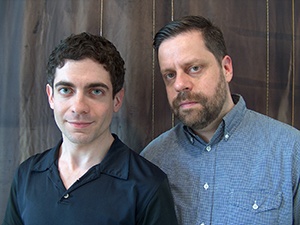“For four days, this Frank Gehry complex, with its riffling steel façade, opened its many-roomed interior to artists blurring the lines between performance and visual art. By the end of the day, it was difficult to think of those disciplines as discrete categories, as anything other than symbiotic, fluid, and inseparable.” —The New York Times
With the recent proliferation of dance in museums, artists and curators have had to reimagine nontheatrical spaces—galleries, passageways, atriums—as sites for performance, a task more delicate and complicated than it might sound. But what if the challenge were inverted? What would happen, say, if a performing arts center temporarily reimagined itself as an art museum? That was the question behind The House Is Open.
Credits
Presented in collaboration with The Center for Curatorial Studies at Bard College
Festival Organizers Gideon Lester, Bob Bursey, and Caleb Hammons
Festival Artists
Jack Ferver/Marc Swanson MFA ’04
John Kelly
Ralph Lemon
Jennifer Monson/iLAND
Nature Theater of Oklahoma
Tad Beck
Festival Photographer Julieta Cervantes
Read the Full ProgramCurators’ Note
The borders between the visual and performing arts are in flux. Many contemporary artists are developing hybrid practices that transcend conventional categories of theater, dance, per- formance, visual art, installation, music, and film. Meanwhile, museums and art galleries are once again embracing live performance, with major institutions in the United States and around the world presenting the work of choreographers and theater artists in galleries that have traditionally displayed painting, photography, and sculpture.
The visual art world’s renewed interest in performance has created new opportunities and challenges for performing artists, and engendered much theoretical and practical discourse among curators, artists, and scholars about institutional identity and infrastructure, the value of live performance in the art market, the compensation and labor of artists, and the possibil- ity (or impossibility) of acquiring and archiving ephemeral works of art. This interdisciplinary traffic has, however, largely flowed in one direction. Performance has entered, and occasionally transformed, visual arts institutions, but performing arts centers—theaters, concert halls, dance venues—have been comparatively unaffected by the art world’s “performative turn.”
The House Is Open is a temporary exhibition that poses a fanciful question: What might happen if a performing arts center returned the compliment by adopting the relational and curatorial strategies of an art museum? For these four days the Richard B. Fisher Center for the Performing Arts is entirely reimagining its interaction with artists and audiences. Six works have been installed throughout the building that in various ways explore the contemporary interplay of visual art and performance. The Center is open all day, and with a single admis- sion ticket the public can wander freely through “galleries” of traditional and nontraditional spaces, creating for themselves a unique itinerary of performances and installations.
Although the exhibition’s experimental framework is temporary and playful, its central inquiry is serious. How might performing arts institutions think differently about the rela- tionship between artists and audiences? Could this experiment lead to new ideas about the creation, funding, and reception of new hybrid art practices? We are eager to learn of your experiences of The House Is Open, and invite you to dream with us about models of specta- torship and engagement in arts centers of the future.
—Gideon Lester, Director of Theater Programs
Works
JACK FERVER/MARC SWANSON MFA ’04
CHAMBRE

Choreographer, writer, and performer Jack Ferver and visual artist Marc Swanson MFA ’04 collaborate on a hybrid performance and art installation inspired by Jean Genet’s iconic play Les Bonnes (The Maids). Chambre is a sometimes farcical, sometimes savage, contemporary exploration of otherness, gender, celebrity, and the class divide.
JOHN KELLY
ESCAPE ARTIST REDUX
While rehearsing a theater show based on the life of the Italian Baroque painter Caravaggio, a stressed-out performer has a catastrophic trapeze accident. Stranded on a gurney in a hospital room with a broken neck, he escapes and finds refuge in the images that flood his mind—the sinners and saints, the prostitutes and gods—that populate Caravaggio’s paintings.
RALPH LEMON
SCAFFOLD ROOM
Acclaimed choreographer and curator Ralph Lemon melds performance, visual art, music, and text in his new work Scaffold Room, an inquisitive hybrid “lecture-performance-musical” that refracts ideas and images of black female personae in American pop and contemporary art culture.
JENNIFER MONSON/ILAND
Live Dancing Archive
Jennifer Monson’s work is a visceral exploration of the dancing body as a physical archive of experience and place. Compiled from more than a decade of dance-based environmental research, Live Dancing Archive draws from video documentation of Monson’s past performances in addition to improvised scores.
NATURE THEATER OF OKLAHOMA
EMPIRE!
Empire is a tribute to Andy Warhol’s 1964 silent, black-and-white film of the same name, remade by Nature Theater of Oklahoma, the internationally renowned theater company. Instead of filming the Empire State Building, as Warhol did, Nature Theater is creating an animated version, drawn by hand, one 4 x 6” index card at a time. It will ultimately last more than eight hours—the same length as Warhol’s film. You’re invited to view the project so far, and contribute your own drawings to the animation.
TAD BECK
DOUBLE DOCUMENT
Double Document hybridizes the traditions of portraiture and performance documentation in a series of photographs that collapse multiple photographic and performative moments into a single image.















